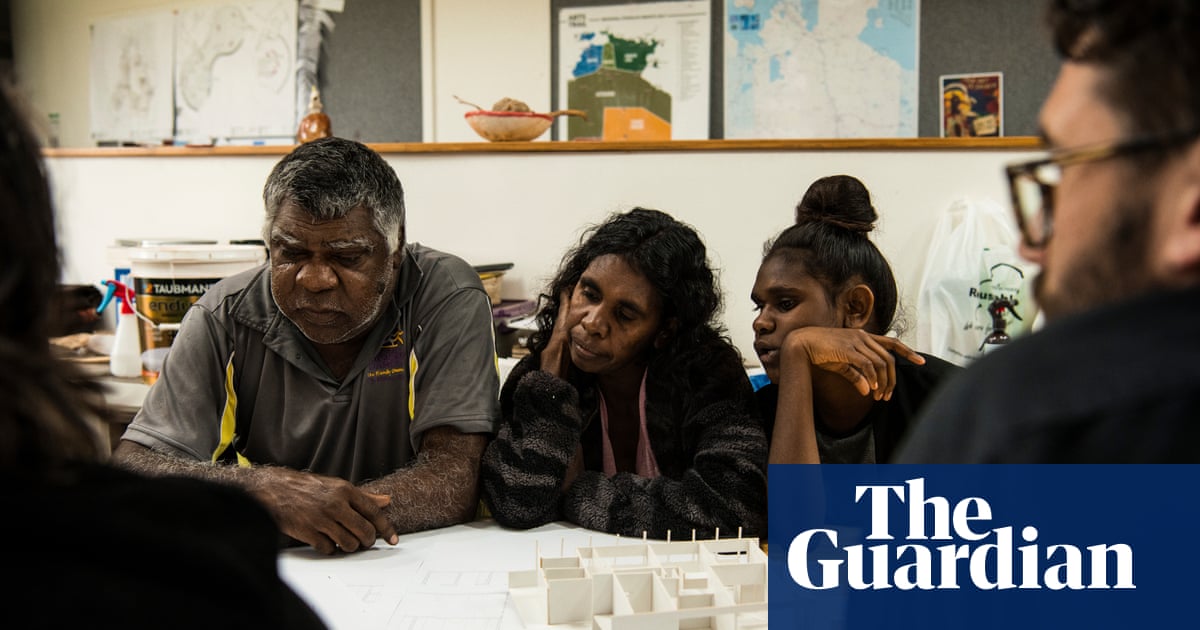It’s hotter inside than out in many of the homes in the remote Northern Territory town of Tennant Creek, where the Warumungu man Jimmy Frank Jupurrurla and his family live. Most lack insulation and guttering. At Drive-in Camp outside town, the homes are tin sheds, disconnected from services since the 2007 intervention but still occupied.
The poor housing is making the residents sick, Jupurrurla says: “I worry about the future – will my grandchildren and their kids be living in prison-like houses? Or are we going to start designing homes that allow us to practise our culture?”
A $1bn investment in remote housing in the NT since 2017 has failed to solve the problem. A further $4bn was pledged in March in a joint announcement by the federal and territory governments. But health experts warn unless authorities commit to a dramatic shift in the way housing is designed and built for Indigenous communities, public health outcomes could worsen.
Poor housing has been blamed for high rates of rheumatic heart disease in the NT.
The preventable condition is caused by repeated, untreated streptococcus A infections and is linked to poverty, overcrowded and inadequate housing and lack of access to healthcare. Australia has one of the highest rates of RHD in the world, and rates have doubled between 2012 and 2021.
Jupurrurla says community participation in decision-making leads to better maintenance and a sense of ownership. He is the chair of Wilya Janta, a cultural consultancy and housing collective based in Tennant Creek which has developed housing designs by Aboriginal people for Aboriginal people.
“For too long, we’ve been given houses we had no say in designing,” he says.
Simon Quilty, a GP based in Tennant Creek, also works with Wilya Janta. He says nothing symbolises the failure of government housing design more clearly than steel trapdoors. These were introduced about five years ago to accommodate future air conditioning installations. But instead of providing relief from the heat they act as conductors, turning homes into ovens.
“If you can’t afford an aircon, then you’ll have a heat-conducting steel plate making you need that aircon even more than if you did have the money to buy one,” Quilty says.
“It is madness, these design lunacies make houses more expensive to build and injure the wellbeing of the resident for no possible gain, to save a few measly bucks.”
Glenn Platt, the executive director of strategy and innovation at Emergent Group, says the metal trapdoor is like “having an extra glass window in the room”. The result is a home which is hotter inside than out, a significant health risk when temperatures are frequently above 40C.
Overcrowded and poorly ventilated housing is a major driver of preventable diseases among Aboriginal communities, with more than half of all Indigenous people in the NT living in overcrowded homes.
Dr John Paterson, the chief executive of the Aboriginal Medical Services Alliance NT, says poor housing contributes to the spread of infectious diseases, hampers early childhood development, affects mental health, and diminishes social and emotional wellbeing.
“Diseases like rheumatic heart disease are better termed diseases of poverty; driven by overcrowded housing, lack of access to washing facilities and palatable drinking water that is unfortunately too common in remote communities, particularly in the central region,” he says.
Overcrowded environments increase the chances of repeated exposure to streptococcus bacteria. While harmless on the skin’s surface or easily managed by antibiotics in communities with good access to health services, repeat infections can lead to immune reactions that scar heart valves.
“We’re asking for the same basic human rights which include the same building standards, the same building repair and maintenance expectations, the same basic functions of a house – like access to suitable drinking water and a continuous power supply – that people living in any other jurisdiction in Australia take for granted,” Paterson says. “But for too long these standards have not been met in remote communities.”
Most government-built homes in remote areas are built using concrete blocks. They have inadequate thermal efficiency, poor ventilation and minimal climate control.
The new housing funding will pay for up to 2,700 new three-bedroom homes over 10 years. The prime minister, Anthony Albanese, said the program was designed to halve overcrowding in Indigenous communities in the NT as part of the Closing the Gap goals. Some 971 new or replacement homes have been built and 489 expanded under other funding deals since 2017.
A federal Department of Housing spokesperson said the new builds would be constructed after consultation with Indigenous communities and Aboriginal Housing NT.
Skye Thompson, AHNT’s chief executive, told Guardian Australia the new homes must be appropriate for the climate and culture of those living in them.
“When houses are built to a lower standard of energy efficiency and works are not subject to a proper certification process; when they are poorly oriented, too hot or stuffy; and when the design doesn’t suit the residents’ family configuration or culture, the return on investment nosedives,” she says.
The NT minister for housing construction, Bill Yan, said the new Country Liberal party government, which swept to victory in August on a platform that included reversing youth justice reforms and lowering the age of criminal responsibility to 10, reaffirmed the NT government’s commitment to the $4bn housing partnership with the federal government.
“The partnership with the federal government is a signed agreement that the new government will honour,” he said. “Territorians living in safe housing is an important part to community safety as well as enjoying our Territory lifestyle.
“We will listen to stakeholders and communities on their housing needs and consider expert advice on any issues prohibiting effective and efficient delivery of remote housing.”

